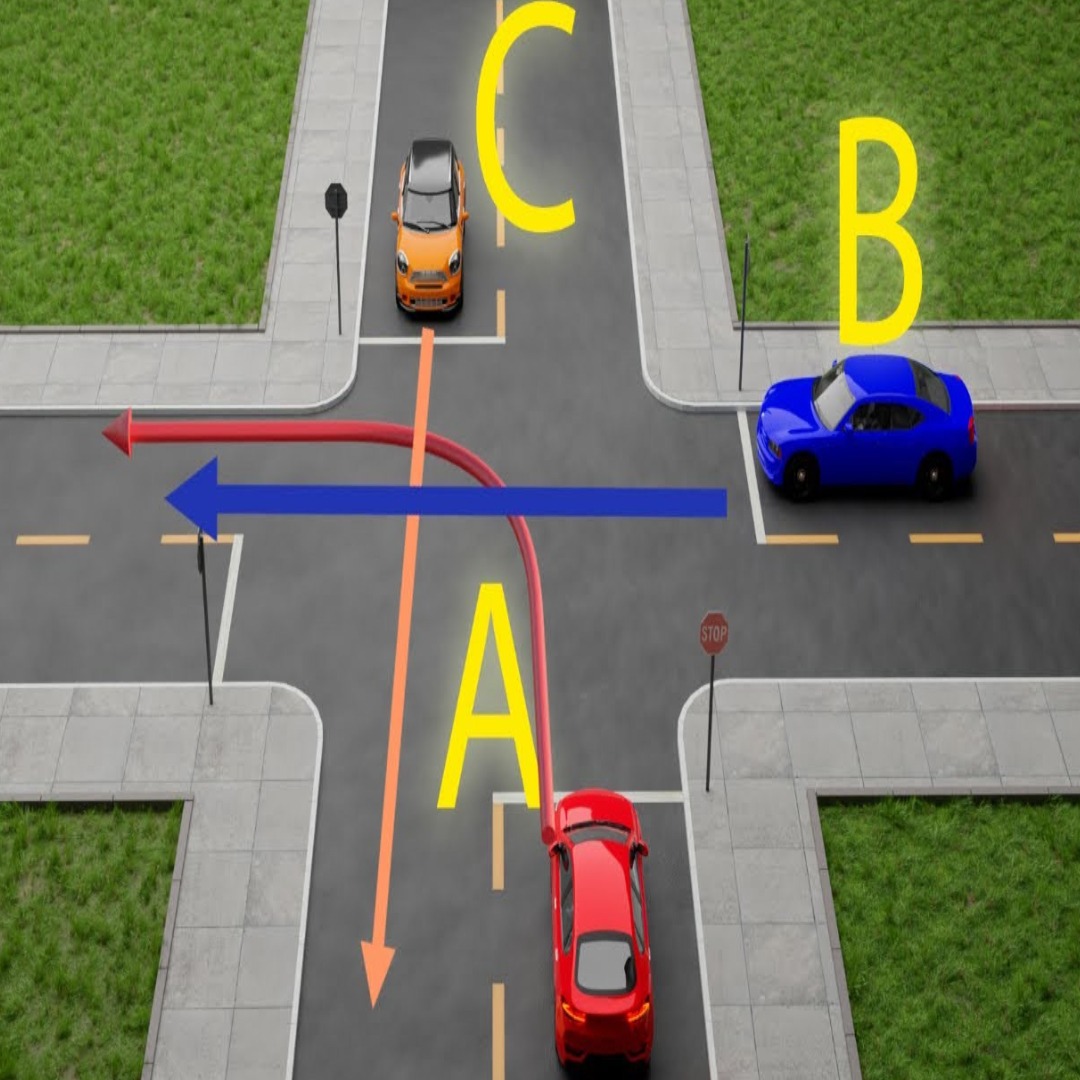Understanding who has the right of way at intersections is crucial for ensuring road safety and maintaining smooth traffic flow. Many drivers face situations where multiple vehicles reach an intersection simultaneously, leading to uncertainty about who should go first. The scenario presented here involves three vehicles approaching an intersection from different directions, each with distinct intentions. The question is: which car has the right of way? The correct answer is Car C. Let’s analyze the reasons behind this conclusion.

Deciphering the Intersection Scenario
In the given scenario, three vehicles—A (red car), B (blue car), and C (orange car)—arrive at an intersection with different planned movements. To determine the right of way, let’s examine the circumstances of each vehicle:
Car A (Red Car): Approaching the intersection from a stop sign, Car A intends to make a left turn across oncoming traffic. Car B (Blue Car): Also at a stop sign, Car B is coming from a minor road and plans to turn right onto the main road. Car C (Orange Car): Moving straight through the intersection on a main road, Car C does not have a stop sign.
Right-of-Way Rules at Intersections
Intersections are regulated by well-defined traffic rules that establish vehicle priority. In this case, the applicable right-of-way principles include:
Traffic Control Signs: Cars A and B both have stop signs, requiring them to yield to any vehicle traveling on the main road. Car C, which does not have a stop sign, holds priority and does not need to stop. Straight Traffic vs. Turning Traffic: Vehicles traveling straight typically have precedence over those making turns, barring any overriding traffic signals. Since Car C is going straight, it takes priority over Cars A and B. Right Turns vs. Left Turns: When two vehicles are at an intersection, the vehicle making a right turn (Car B) has priority over the vehicle making a left turn (Car A), as the latter must cross oncoming traffic.
Analyzing Vehicle Movements
Car C (Orange Car): Since Car C is moving straight on the main road and does not have a stop sign, it holds the right of way and can proceed without stopping. Car B (Blue Car): Although Car B intends to turn right, it must yield to Car C because it faces a stop sign and is entering the main road. Car A (Red Car): Car A must yield to both Cars C and B. It is turning left across traffic and faces a stop sign, placing it last in priority.
Why Car C Has the Right of Way
Car C has the right of way because:
It is traveling on the main road without any stop signs restricting its movement. Vehicles coming from minor roads with stop signs must yield to those traveling on the main road. Since Car C is moving straight and not turning, its path is the least obstructed, giving it priority over the other vehicles.
Common Right-of-Way Mistakes
Misunderstanding right-of-way rules can create dangerous situations. Here are some common mistakes drivers make at intersections:
Assuming Equal Priority: Some drivers mistakenly believe that all vehicles arriving at an intersection at the same time share equal priority, leading to confusion and possible collisions. Rushing Through Intersections: Being too aggressive or hesitant can disrupt the natural traffic flow and increase accident risks. Drivers should proceed cautiously and in accordance with the rules. Ignoring Stop Signs: Some drivers fail to make a complete stop at stop signs, which can result in dangerous situations when merging onto the main road.
The Importance of Yielding
Yielding when necessary plays a crucial role in preventing accidents and maintaining smooth traffic movement. Here’s why yielding matters:
Prevents Collisions: Adhering to right-of-way rules significantly reduces the risk of accidents. Enhances Traffic Efficiency: Yielding at the right moments keeps traffic flowing smoothly and avoids unnecessary delays. Ensures Legal Compliance: Failure to yield properly can lead to legal penalties, including fines and citations.
Safe Driving Tips for Intersections
To stay safe and avoid confusion at intersections, follow these essential tips:
Observe Traffic Signs: Always pay close attention to stop signs, yield signs, and traffic signals to determine your right of way. Anticipate Other Drivers’ Actions: Stay alert and be prepared for unexpected moves by other vehicles. Communicate Clearly: Use turn signals to indicate your intentions and ensure predictable movements. Exercise Patience: Never rush through an intersection. Wait your turn and ensure the way is clear before proceeding.
Conclusion: Why Car C Takes Priority
In this particular scenario, Car C holds the right of way because it is traveling straight on the main road without stop signs. Cars A and B must yield due to their stop signs, and Car A must further yield to Car B because of its left-turning maneuver.
Understanding and respecting right-of-way rules are critical for preventing accidents and ensuring traffic moves efficiently. The next time you approach an intersection like this, take a moment to assess the situation, follow the rules, and yield when required. Safe driving starts with informed decision-making and adherence to established traffic laws.





